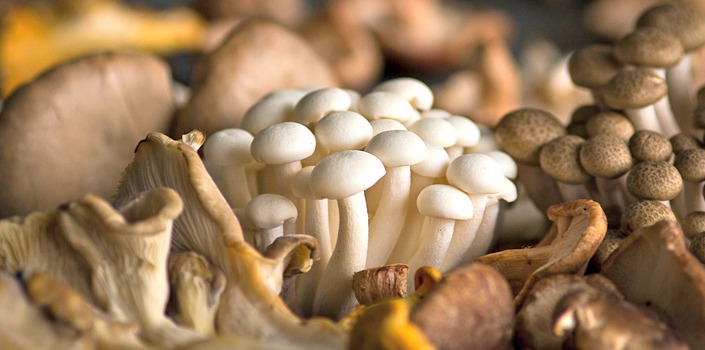Making the Most of Magical Mushrooms!

Autumn is not only the season for mushroom foraging, but the best time of year for mushroom cooking too.
Here's our guide to all things mushrooms! Have a read.
What to Look for When Buying Mushrooms
- When you’re shopping for mushrooms, look out for ‘wild’ selections, which often contain shiitake, chanterelles, oyster and shimeji, and then make up the remaining quantity you need for your recipe with chestnut mushrooms.
- Choose a pack that looks fresh and dry and avoid those that appear wet, or damp. Always try to eat mushrooms while they are as fresh as possible, and your local greengrocers or farmer’s market will most likely have the freshest.
How to Prepare Mushrooms for Cooking
Never wash mushrooms! They contain 90 per cent water and will act like sponges, soaking up the moisture and becoming soggy. To clean them, just wipe with a pastry brush or paper towel, or you can buy a special mushroom brush.
The exception to this rule is when you are using wild mushrooms, which may be very gritty. These may need a gentle plunge into a bowl of water; but not a running tap, as this is too violent and may damage them. Always dry the mushrooms with paper towel before cooking.
How to Store Mushrooms
Store mushrooms in a paper bag in the fridge, and never in plastic or in a bowl covered with cling film as this will make them sweat. Mushrooms can be frozen but only when cooked: simply sauté́ them in oil or vegan butter and freeze in small quantities.
They can then be cooked from frozen or defrosted an hour before you intend to use them. When defrosted, cooked mushrooms become watery and loose in texture, so are best used for liquid dishes such as soups.
How to Cook Mushrooms
Cook mushrooms in rapeseed oil, olive oil or vegan butter. Olive oil is preferable, as the flavour complements mushrooms best, but sometimes a mixture of vegan butter and olive oil is welcomed if you want a richer flavour!
Mushrooms also love heat, and should sizzle when they cook to seal in the flavour and evaporate their moisture. It is best to leave them alone, and try not to stir as they wont crisp up if they are moved around too much.
They generally release a lot of their moisture during cooking and then draw it back in, so wait for the point when they become dry and begin to crisp on the edges. Add your seasoning at the end of cooking, as salt will draw out even more moisture.
Mushroom Varieties
Fresh Mushrooms
CHESTNUT mushrooms are brown-cap mushrooms, have more flavour than white-cap mushrooms and are often organic.
CHANTERELLES have a beautiful orange colour and have a very distinctive taste. They can be cooked whole and are best sautéed in butter or olive oil. They are also called girolles in France.
OYSTER mushrooms have short stalks on one side of the smooth bare oyster-like cap, which can be up to 15cm in diameter. They grow on the trunks of deciduous trees. They have a delicate flavour so are best in light creamy dishes, shredded by hand and quickly stir-fried.
KING OYSTER mushrooms are from the same family as oyster mushrooms and are sometimes called trumpet mushrooms. They have a dense texture and a sweet mild taste. Slice them lengthwise and pan- fry, grill or bake.
PORCINI or ceps are found wild in the woods in autumn. To cook fresh, slice thickly and fry or char-grill, then drizzle with the best olive oil. You can also buy them dried, with a more concentrated flavour.
SHIITAKE are tough, dark brown mushrooms with a ‘meaty’ flavour. They grow on tree logs and are available to buy fresh and dried. Shiitake are well suited to Asian dishes, but will also add taste to stews, risottos and soups.
SHIMEJI are popular Japanese mushrooms and are known as white or brown beech mushrooms, as in the wild they grow on fallen beech trees. They have a nutty flavour and chewy texture. These are delicious when lightly pickled!
Dried Mushrooms
Dried mushrooms are an essential store cupboard ingredient.
Use them to add flavour to stocks and soups by just adding a few, whole, or rehydrate them in hot water and then chop them into risottos, pasta dishes or stews.
Dried porcini and shiitake mushrooms are great, as they are so full of flavour that you don’t need to use many to add a wonderful mushroom aroma to your dishes. After rehydrating, you can use the soaking liquid as a stock, just strain off any grit and dirt at the bottom of the soaking bowl first.
Photos by Rob Wicks of Eat Pictures
Here are a few of our favourite mushroom recipes ~
- Hazelnut, Mushroom, Squash and Butterbean Galette
- Kimchi Stew with Tofu and Mushrooms
- Mushroom, Ale and Celeriac Pie
- Okonomiyaki
- Tom yam with shiitake mushrooms
- Chestnut Mushroom, Hazelnut and Smoked Tofu Pate
- Japanese Soba Noodles with Mushrooms
We have some fabulous courses lined up for Autumn and into Winter and our Christmas Classes are filling up very quickly. Why not click over right now and book yourself or a friend (or both!) onto a course at our beautiful school in the heart of Bath?
What will you be making with mushrooms as autumn unfolds? Leave a comment below or Find us on Facebook, Twitter, Pinterest and Instagram where we are chatting about all things foodie and, if you like this post, please share it!
To keep up to date with events and goings on at the cookery school sign up for our newsletter.



